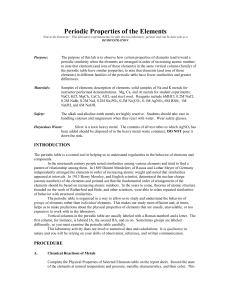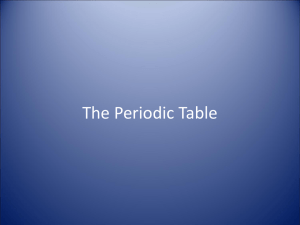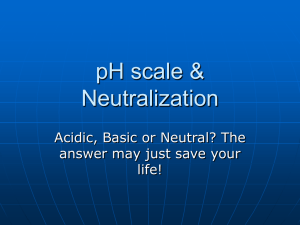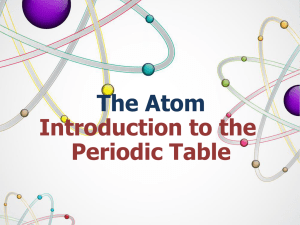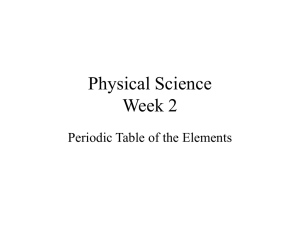Periodic Properties of the Elements
advertisement
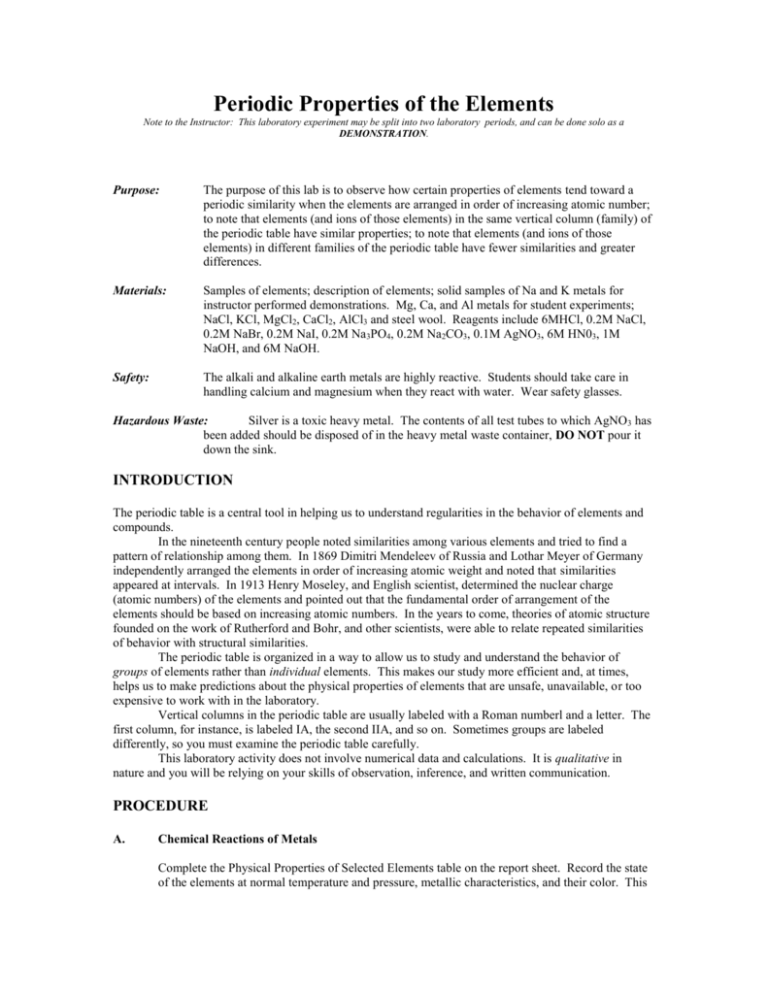
Periodic Properties of the Elements Note to the Instructor: This laboratory experiment may be split into two laboratory periods, and can be done solo as a DEMONSTRATION. Purpose: The purpose of this lab is to observe how certain properties of elements tend toward a periodic similarity when the elements are arranged in order of increasing atomic number; to note that elements (and ions of those elements) in the same vertical column (family) of the periodic table have similar properties; to note that elements (and ions of those elements) in different families of the periodic table have fewer similarities and greater differences. Materials: Samples of elements; description of elements; solid samples of Na and K metals for instructor performed demonstrations. Mg, Ca, and Al metals for student experiments; NaCl, KCl, MgCl2, CaCl2, AlCl3 and steel wool. Reagents include 6MHCl, 0.2M NaCl, 0.2M NaBr, 0.2M NaI, 0.2M Na3PO4, 0.2M Na2CO3, 0.1M AgNO3, 6M HN03, 1M NaOH, and 6M NaOH. Safety: The alkali and alkaline earth metals are highly reactive. Students should take care in handling calcium and magnesium when they react with water. Wear safety glasses. Hazardous Waste: Silver is a toxic heavy metal. The contents of all test tubes to which AgNO 3 has been added should be disposed of in the heavy metal waste container, DO NOT pour it down the sink. INTRODUCTION The periodic table is a central tool in helping us to understand regularities in the behavior of elements and compounds. In the nineteenth century people noted similarities among various elements and tried to find a pattern of relationship among them. In 1869 Dimitri Mendeleev of Russia and Lothar Meyer of Germany independently arranged the elements in order of increasing atomic weight and noted that similarities appeared at intervals. In 1913 Henry Moseley, and English scientist, determined the nuclear charge (atomic numbers) of the elements and pointed out that the fundamental order of arrangement of the elements should be based on increasing atomic numbers. In the years to come, theories of atomic structure founded on the work of Rutherford and Bohr, and other scientists, were able to relate repeated similarities of behavior with structural similarities. The periodic table is organized in a way to allow us to study and understand the behavior of groups of elements rather than individual elements. This makes our study more efficient and, at times, helps us to make predictions about the physical properties of elements that are unsafe, unavailable, or too expensive to work with in the laboratory. Vertical columns in the periodic table are usually labeled with a Roman numberl and a letter. The first column, for instance, is labeled IA, the second IIA, and so on. Sometimes groups are labeled differently, so you must examine the periodic table carefully. This laboratory activity does not involve numerical data and calculations. It is qualitative in nature and you will be relying on your skills of observation, inference, and written communication. PROCEDURE A. Chemical Reactions of Metals Complete the Physical Properties of Selected Elements table on the report sheet. Record the state of the elements at normal temperature and pressure, metallic characteristics, and their color. This information is available from a variety of sources found in the library or from your instructors. One very important reference is the CRC Handbook of Chemistry and Physics. B. Chemical Reactions of Metals 1. Group IA (alkali metals): Na, K demonstration. These elements are very reactive and not found in nature in the free elemental form. The following equation represents the typical violent reaction between an alkali metal and water. 2 Na + 2 H2O 2 NaOH + H2 Record your observations on the report sheet. Using your observations, make a conclusion about the trend in the chemical behavior of alkali metals. 2. Group IIA: Mg and Ca (Alkaline-earth metals). CAUTION! DO NOT HOLD THE TEST TUBES WITH REACTING SUBSTANCES IN YOUR HANDS. Put a small piece of Mg and a small piece of Ca into separate test tubes. Add 5 ml of distilled water into each test tubes. Observe and record any physical changes that indicate a chemical reaction has occurred. 3. Group IIIA: Al. Clean a small piece of aluminum metal with steel wool. Place the aluminum into a clean test tube and add 5 ml of distilled water. Record your observations. Add 5 drops of 6M HCl to the test tube. If no change, add an additional 5 ml of HCl. Record your observations. C. Chemical Reactions of compounds Containing Ions 1. Groups IA, IIA, and IIIA metal ions. Put 5 ml of distilled water into each of 5 clean test tubes. Put a small amount of sodium chloride (NaCl) into the first test tube. In the remaining test tubes place the same amount of potassium chloride (KCl), magnesium chloride (MgCl2), calcium chloride (CaCl2), and aluminum chloride (AlCl3). Mix and dissolve thoroughly and record your observations. Now add 1ml of 1M NaOH to each test tube, mix thoroughly and note any changes. Then add 1 ml of 6M NaOH to the contents of each test tube. Mix thoroughly. Observe any reactions. 2. Nonmetal Ions: halides (group VIIA), phosphates and carbonates. Put 5 ml of each of the following solutions into separate clean test tubes. Elements or ions that belong to group VIIA which is the family of elements known as the halogens. Negatively charged ions (anions) of the halogens are known as halide ions. 0.2M NaCl, chloride ion (Cl-) 0.2M NaBr, bromide ion (Br-) 0.2M NaI, iodide ion (I-) 0.2M Na3PO4, phosphate ion (PO43-) 0.2M Na2CO3, carbonate ion (CO32-) Add 1 ml of 0.1M AgNO3 (silver nitrate) to each test tube. Mix thoroughly. Let stand 5 minutes, and record your observations. Then slowly and carefully add 1 ml 6M HNO3 to each test tube, mix until a change is observed in the phosphate and carbonate solutions. Observe closely. 3. Unknown salt. Obtain an unknown solid and record its number on your report sheet. Place 3 ml distilled water into two test tubes and add a small amount of unknown into each test tube. Mix until dissolved. Add 1 ml of 1M NaOH to the first test tube. Mix and record your observation. If a solid forms (precipitate - ppt), add 1 ml 6M NaOH and mix thoroughly and note any reactions.Identify your unknown based on your observations and indicate on your report sheet which of the three groups the salt belongs. To the second test tube add 1 ml of 0.1M AgNO3 solution. Mix thoroughly and allow the mixture to stand for five minutes. Record your observations. Then add slowly 2 ml 6M HNO3 and mix thoroughly. Record your observations and identify the anion as being either a carbonate, phosphate or a halide. Name_____________ Date__________________ REPORT SHEET Physical Properties of Selected Elements Group IA Element Lithium Sodium Potassium IIA Beryllium Magnesium Calcium IB Copper IIB Zinc Cadmium Mercury IVA Carbon Silicon Tin VA Nitrogen Phosphorus Arsenic State (solid, liquid, gas) Metal, Nonmetal, Semimetal Color Symbol VIA Oxygen Sulfer VIIA Chlorine Bromine Iodine B. Chemical Reactions of Metals 1. Group IA: Na, K (alkali metals) Demonstration. Element Sodium Potassium Behavior in Cold Water Which elements observed in Group IA appear to be: a. Most reactive with water? _________________________________________________________ b. Least reactive with water? _________________________________________________________ For Group IA metals, what is the trend for reactivity with water as atomic number increases. 2. Group IIA: Mg and Ca (alkaline-earth) metals Elements Magnesium Calcium Behavior in Cold Water 6M HCl added From your observation, which elements in Group IIA is more reactive. Explain based on your observations. 3. Group IIIA: Al Element Aluminum In Cold Water Behavior 6M HCL Extra 6M HCl From your data, arrange the three periodic groups in order of increasing reactivity with cold water (least reactive listed first) ______________________________ C. Chemical Reactions of compounds Containing Ions 1. Groups IA, IIA, and IIIA metal ions. Compound NaCl KCl MgCl2 CaCl2 AlCl3 In water Behavior 1M NaOH 6M NaOH Are the metal ions grouped together in the table also grouped together in vertical columns in the periodic table? 2. Nonmetal Ions: Halides, phosphates and caronates Compound NaCl NaBr NaI Na3PO4 Na2CO3 Behavior with AgNO3 Behavor with HNO3 Do the halide ions have similar chemical behaviors? Explain. Compare the compounds containing the carbonate and phosphate ions to the compounds containing halide ions. Are the chemical reactions similar or different? Explain based on your observations. 3. Salt containing a group IA, IIA, or IIIA cation and a halide, carbonate or phosphate anion Reaction with 1MNaOH 6M NaOH Observed Behavior The unknown solid contains a cation from Group__________in the periodic table Compound Unknown Salt Behavior with AgNO3 The unknown solid contains anion from Group__________in the periodic table. Behavior with HNO3
